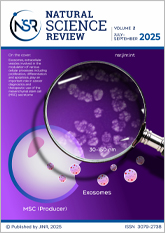New issue of Natural Science Review
News, 01 October 2025
The fourth issue of the international Natural Science Review journal (July – September 2025) was published. It features papers on astrophysics, high energy physics, and biology, along with nuclear and accelerator physics.
A joint article by employees of JINR, Moscow State University, and the Federal State Budgetary Institution “National Medical Research Centre for Rehabilitation and Balneology” of the Ministry of Health of the Russian Federation, “Comparative analysis of enriched mesenchymal stem cells conditioned medium fractions obtained by ultrafiltration”, is devoted to the development of a methodology for obtaining components of a conditioned medium enriched by ultrafiltration using human mesenchymal stem cells (MSCs) and conducting a comparative analysis of them. The data presented in this paper emphasises the importance of selecting culture conditions and providing information to determine the optimal strategy for obtaining a stem cell secretome balancing yield, purity, and regulatory demands in MSC research and therapy.
The review article entitled “Shadow in the galactic centre: theoretical concept – prediction – realisation” by Alexander Zakharov, a leading researcher at the Laboratory of Theoretical Physics at JINR and the Kurchatov Institute National Research Centre, is devoted to the analysis of theoretical concepts and observational tests of the general theory of relativity (GR). The author discusses the historical aspects of the development of physical cosmology, as well as the achievements of theoretical and observational studies of general relativity. Special attention is paid to the evolution of the concept of the black hole shadow, which led to new ideas for GR tests and alternative theories of gravity. The concept of the black hole shadow as an object of a thought experiment was first considered in the work of James Bardeen in 1973. Bardeen did not focus on astronomical black holes and the means of astronomical observations required to reconstruct the shadows of such black holes. Thanks to the development of observational astronomy tools and the evolution of means of big data analysis, the International Event Horizon Telescope (EHT) Collaboration reconstructed the shadows of black holes in the Galactic Centre (Sgr A*) in 2022 and the centre of the M87 (M87*) galaxy in 2019. The ability to estimate the size and shape of the shadow of a black hole in the Galactic Centre was predicted earlier in the work of Alexander Zakharov and his Italian colleagues, published in New Astronomy in 2005. Over the 50 years, the concept of the black hole shadow has developed from a theoretical concept to predictions of the shape and size of the shadow image, which was made possible by EHT observations.
The work of BLTP JINR employees Mikhail Volkov, Aleksei Pivovarov, and Kanat Nurlan entitled “Decays τ → ππηντ and τ → πηηντ in the extended Nambu–Jona-Lasinio model” is devoted to considering tau lepton decays in the extended Nambu-Jona-Lasinio model, taking into account mesons in the ground and first radially excited states. The calculation results, taking into account the decay channels considered, are in satisfactory agreement with recent experimental data from BaBar and CMD-3, while differing from the averaged values of the Particle Data Group tables.
The work of a group of scientists from the Joint Institute for Nuclear Research, “Progress in the design and modelling methods of the MSC230 Superconducting Cyclotron for proton therapy”, examines in detail the issues of the design methodology of the high-current MSC230 Accelerator being developed at JINR. The facility’s purpose is to produce high-intensity proton beams for advanced biomedical studies, particularly for flash therapy. Specialists of the Efremov Scientific Research Institute of Electrophysical Apparatus are working on the technical design of the cyclotron. Thanks to the design and modelling methods described in the article, the accelerator under development opens up prospects for more effective and affordable treatment of oncological diseases.
The work of a team of Vietnamese researchers from the Centre for Nuclear Techniques, the Dalat Nuclear Research Institute, and Thu Dau Mot University is devoted to a new method of neutron activation analysis at a research reactor in Dalat. The authors propose an optimised k0-standardised neutron activation analysis method incorporating cyclic irradiations (k0-CNAA) for short-lived radionuclides. The approach using short-lived radionuclides with half-lives from a few seconds to minutes enables the quantification of elements essential for biological and environmental research. The paper highlights precise reactor parameter characterisation using a cyclic irradiation system, simple sample preparation, advanced calibration of gamma-ray spectrometry for the rapid multielement determination of short-lived radionuclides, and updated data processing software.
Natural Science Review is an international peer-reviewed online scientific journal published by the Joint Institute for Nuclear Research since December 2024. Quarterly issues of Natural Science Review cover a wide range of scientific topics: physics, fundamental and applied research, interdisciplinary research, mathematical and computer sciences, life sciences, Earth sciences, chemistry, etc.
